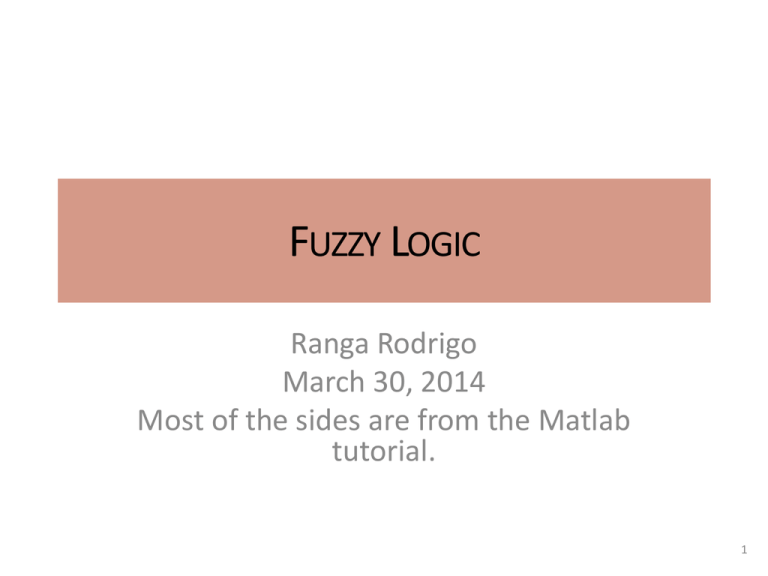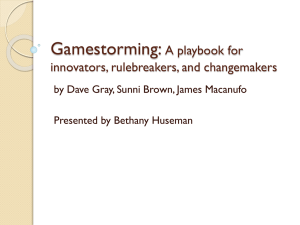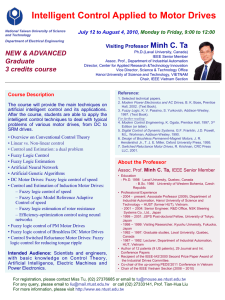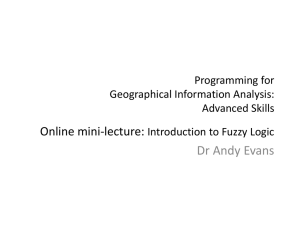Fuzzy Logic
advertisement

FUZZY LOGIC
Ranga Rodrigo
March 30, 2014
Most of the sides are from the Matlab
tutorial.
1
INTRODUCTION
• Fuzzy logic is due to the 1965
paper by Prof. Lofti A. Zadeh.
• Fuzzy logic is a form of manyvalued logic; it deals with
reasoning that is approximate
rather than fixed and exact.
• Compared to traditional binary
sets (true or false values) fuzzy
logic variables may have a
truth value that ranges in
degree between 0 and 1 (no
and yes).
2
http://www.ieeeghn.org/wiki/index.php/Lotfi_A._Zadeh
HUMAN REASONING
• Fuzzy systems attempts to mimic human reasoning.
• It can capture the degree of belongingness. E.g.,
– Is a student short, or tall?
– In classical logic: h > 6 feet is tall and h 6 is short.
– How about 5 feet 11 inches? Some may call this tall, and
some may call it short.
– This information is captured as a matter of degree
• This “degree” is called a truth value.
3
OVERVIEW OF A FUZZY INFERENCE SYSTEM
• The point of fuzzy logic is to map an input space to
an output space.
• The input space consists of a vector of truth values.
• The primary mechanism for doing this is a list of ifthen statements called rules.
4
PROCESS
Fuzzification
Crisp input Fuzzy input
Apply Fuzzy Operators and
Implication
Fuzzy set
Defuzzyfication
Crisp output
5
A FUZZY INFERENCE SYSTEM (FIS)
A General Case
Input
Output
Service
Tip
If service is good then tip is cheap
If service is good then tip is average
If service is excellent then tip is generous
Rules
Input terms
(interpret)
A Specific Example
Output terms
(assign)
Service is
interpreted as
{poor, good,
excellent}
Tip is assigned to
be {cheap,
average,
generous}
A FIS interprets the values in the input vector and, based on some
set of rules, assigns values to the output vector.
6
FUZZY SETS
• Fuzzy logic starts with the concept of a fuzzy set.
• A fuzzy set is a set without a crisp, clearly defined
boundary.
• It can contain elements with only a partial degree of
membership.
7
FUZZY SETS EXAMPLE
A classical set: The set of days of the
week unquestionably includes Monday,
Thursday, and Saturday. It just as
unquestionably excludes butter, liberty,
and dorsal fins, and so on.
Of any subject, one thing must be
either asserted or denied
A fuzzy set: Most would agree that
Saturday and Sunday belong, but what
about Friday? It feels like a part of the
weekend, but somehow it seems like it
should be technically excluded.
In fuzzy logic, the truth of any statement
becomes a matter of degree.
8
FUZZY SETS EXAMPLE CONTD.
• Reasoning in fuzzy logic is a matter of generalizing the
familiar yes-no (Boolean) logic.
• If true = 1 and false = 0, fuzzy logic also permits inbetween values like 0.2 and 0.7453.
• Q: Is Saturday a weekend day?
– A: 1 (yes, or true)
• Q: Is Tuesday a weekend day?
– A: 0 (no, or false)
• Q: Is Friday a weekend day?
– A: 0.8 (for the most part yes, but not completely)
• Q: Is Sunday a weekend day?
– A: 0.95 (yes, but not quite as much as Saturday).
9
Truth values for weekend-ness if
forced to respond with an
absolute yes or no response
Truth value for weekend-ness if
allowed to respond with fuzzy inbetween values
Continuous-scale Time Plot of Weekend-ness for Two-valued And Multi-Valued
Membership
10
EXAMPLE OF APPLYING TRUTH VALUES
• A temperature measurement for anti-lock brakes
• Each function maps the same temperature value to
a truth value in the 0 to 1 range.
• These truth values can then be used to determine
how the brakes should be controlled.
Truth values of each of
the three functions at a
particular temperature
11
http://en.wikipedia.org/wiki/Fuzzy_logic
MEMBERSHIP FUNCTIONS
• A membership function (MF) is a curve that defines
how each point in the input space is mapped to a
membership value (or degree of membership)
between 0 and 1.
• The input space is sometimes referred to as the
universe of discourse.
12
MEMBERSHIP FUNCTIONS CONTD.
• A smoothly varying curve that passes from not-tall
to tall is the right way to represent.
• The output-axis is a number known as the
membership value between 0 and 1.
• The curve is known as a membership function and is
often given the designation of µ.
13
14
MEMBERSHIP FUNC. IN FUZZY LOGIC TOOLBOX
Triangular Membership
Function
Gaussian Membership
Function
Trapezoidal Membership
Function
Sigmoid Membership
Function
15
LOGICAL OPERATIONS
• Fuzzy logical reasoning is the fact that it is a
superset of standard Boolean logic.
Standard Truth Table
Fuzzy Truth Table
AND: min(A,B)
OR: max(A,B)
NOT: 1-A
16
APPLICATION OF LOGICAL OPERATORS
17
IF-THEN RULES
• Fuzzy sets and fuzzy operators are the subjects and
verbs of fuzzy logic. These if-then rule statements
are used to formulate the conditional statements
that comprise fuzzy logic.
• A single fuzzy if-then rule assumes the form
if x is A then y is B
• An example of such a rule might be
If service is good then tip is average
The if-part of the rule "x is A" is called the
antecedent or premise.
While the then-part of the rule "y is B" is
called the consequent or conclusion.
18
IF-THE RULES CONTD.
• In general, the input to an if-then rule is the current
value for the input variable (in this case, service)
• The output is an entire fuzzy set (in this case,
average).
• This set will later be defuzzified, assigning one value
to the output.
19
PROCESS
Fuzzification
Crisp input Fuzzy input
Apply Fuzzy Operators and
Implication
Fuzzy set
Defuzzyfication
Crisp output
20
LOGICAL OPERATION OF THEN
• The implication function then modifies that fuzzy
set to the degree specified by the antecedent.
• The most common ways to modify the output fuzzy
set are
– truncation using the min function
– scaling using the prod function
21
22
SUMMARY OF IF-THEN RULES
• Interpreting if-then rules is a three-part process.
• Fuzzify inputs: Resolve all fuzzy statements in the antecedent to a
degree of membership between 0 and 1. If there is only one part
to the antecedent, then this is the degree of support for the rule.
• Apply fuzzy operator to multiple part antecedents: If there are
multiple parts to the antecedent, apply fuzzy logic operators and
resolve the antecedent to a single number between 0 and 1. This is
the degree of support for the rule.
• Apply implication method: Use the degree of support for the
entire rule to shape the output fuzzy set. The consequent of a
fuzzy rule assigns an entire fuzzy set to the output. This fuzzy set is
represented by a membership function that is chosen to indicate
the qualities of the consequent. If the antecedent is only partially
true, (i.e., is assigned a value less than 1), then the output fuzzy
set is truncated according to the implication method.
23
SUMMARY OF IF-THEN RULES CONTD.
• In general, one rule alone is not effective.
• Two or more rules that can play off one another are
needed.
• The output of each rule is a fuzzy set.
• The output fuzzy sets for each rule are then
aggregated into a single output fuzzy set.
• Finally the resulting set is defuzzified, or resolved to
a single number.
24
FUZZY INFERENCE SYSTEMS
25
WHAT ARE FUZZY INFERENCE SYSTEMS?
• Fuzzy inference is the process of formulating the
mapping from a given input to an output using
fuzzy logic.
• The mapping then provides a basis from which
decisions can be made, or patterns discerned.
• The process of fuzzy inference involves all of the
pieces:
– Membership Functions
– Logical Operations
– If-Then Rules.
• We concentrate on the Mamdani-type FIS (Ebrahim
Mamdani in 1975).
26
APPLICATIONS OF FIS
•
•
•
•
•
Automatic control
Data classification
Decision analysis
Expert systems
Computer vision
http://www.lg.com/au/washing-machines/lg27
WT-H650-top-loader-washing-machine
OVERVIEW OF FUZZY INFERENCE PROCESS
28
STEP 1. FUZZIFY INPUTS
• The first step is to take the inputs and determine
the degree to which they belong to each of the
appropriate fuzzy sets via membership functions.
29
STEP 2. APPLY FUZZY OPERATOR
• After fuzzification, the degree to which each part of the
antecedent is satisfied for each rule is known. If the
antecedent of a given rule has more than one part, the
fuzzy operator is applied to obtain one number that
represents the result of the antecedent for that rule.
30
STEP 3. APPLY IMPLICATION METHOD
• After applying a weight to each rule, the implication
method is implemented. A consequent is a fuzzy set
represented by a membership function, which weights
appropriately the linguistic characteristics that are
attributed to it. The consequent is reshaped using a
function associated with the antecedent (a single number).
31
32
STEP 4. AGGREGATE ALL OUTPUTS
• Because decisions are based on the testing of all of
the rules in a FIS, the rules must be combined in
some manner in order to make a decision.
Aggregation is the process by which the fuzzy sets
that represent the outputs of each rule are
combined into a single fuzzy set.
• Methods:
– max (maximum)
– probor (probabilistic OR)
– sum (simply the sum of each rule's output set)
33
fuzzy tipper
34
STEP 5. DEFUZZIFY
• The input for the defuzzification process is a fuzzy
set (the aggregate output fuzzy set) and the output
is a single number. As much as fuzziness helps the
rule evaluation during the intermediate steps, the
final desired output for each variable is generally a
single number. However, the aggregate of a fuzzy
set encompasses a range of output values, and so
must be defuzzified in order to resolve a single
output value from the set.
• Methods: centroid, bisector, middle of max, largest
of max, smallest of max.
35
36
SUMMARY
37
38







